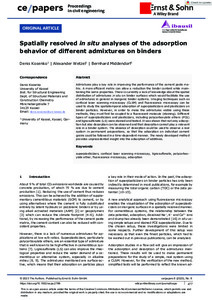Spatially resolved in situ analyses of the adsorption behavior of different admixtures on binders
| dc.date.accessioned | 2024-01-10T09:15:53Z | |
| dc.date.available | 2024-01-10T09:15:53Z | |
| dc.date.issued | 2023-12-06 | |
| dc.identifier | doi:10.17170/kobra-202401109346 | |
| dc.identifier.uri | http://hdl.handle.net/123456789/15358 | |
| dc.description.sponsorship | Gefördert im Rahmen des Projekts DEAL | |
| dc.language.iso | eng | |
| dc.rights | Attribution-NonCommercial-NoDerivatives 4.0 International | * |
| dc.rights.uri | http://creativecommons.org/licenses/by-nc-nd/4.0/ | * |
| dc.subject | superplasticizers | eng |
| dc.subject | confocal laser scanning microscopy | eng |
| dc.subject | lignosulfonate | eng |
| dc.subject | polycarboxylate ether | eng |
| dc.subject | fluorescence microscopy | eng |
| dc.subject | adsorption | eng |
| dc.subject.ddc | 600 | |
| dc.subject.ddc | 660 | |
| dc.title | Spatially resolved in situ analyses of the adsorption behavior of different admixtures on binders | eng |
| dc.type | Aufsatz | |
| dcterms.abstract | Admixtures play a key role in improving the performance of the cement paste matrix. A more efficient matrix can allow a reduction the binder content while maintaining the same properties. There is currently a lack of knowledge about the spatial distribution of admixtures in situ on binder surfaces which would facilitate the use of admixtures in general in inorganic binder systems. Imaging techniques such as confocal laser scanning microscopy (CLSM) and fluorescence microscopy can be used to study the spatiotemporal adsorption of superplasticizers and plasticizers on binder particles. However, in order to make the admixtures visible using these methods, they must first be coupled to a fluorescent molecule (staining). Different types of superplasticizers and plasticizers, including polycarboxylate ethers (PCE) and lignosulfonate (LS) were stained and tested. It was shown that not only adsorption but also desorption can be observed and that desorption cannot play a relevant role in a binder system. The absence of desorption could be used to observe a real system in permanent preparations, so that the adsorption on individual cement grains could be followed in a time-dependent manner. The newly developed method provides unprecedented insight into the adsorption of additives. | eng |
| dcterms.accessRights | open access | |
| dcterms.creator | Kosenko, Denis | |
| dcterms.creator | Wetzel, Alexander | |
| dcterms.creator | Middendorf, Bernhard | |
| dc.relation.doi | doi:10.1002/cepa.2798 | |
| dc.subject.swd | Adsorption | ger |
| dc.subject.swd | Betonverflüssiger | ger |
| dc.subject.swd | Lignin | ger |
| dc.subject.swd | Ether | ger |
| dc.subject.swd | Polycarboxylate | ger |
| dc.subject.swd | Fluoreszenzmikroskopie | ger |
| dc.type.version | publishedVersion | |
| dcterms.source.identifier | eissn:2509-7075 | |
| dcterms.source.issue | Issue 6 | |
| dcterms.source.journal | ce/papers | eng |
| dcterms.source.pageinfo | 477-483 | |
| dcterms.source.volume | Volume 6 | |
| kup.iskup | false | |
| dcterms.source.articlenumber | 2798 |
Files in this item
This item appears in the following Collection(s)
-
Artikel [1109]


